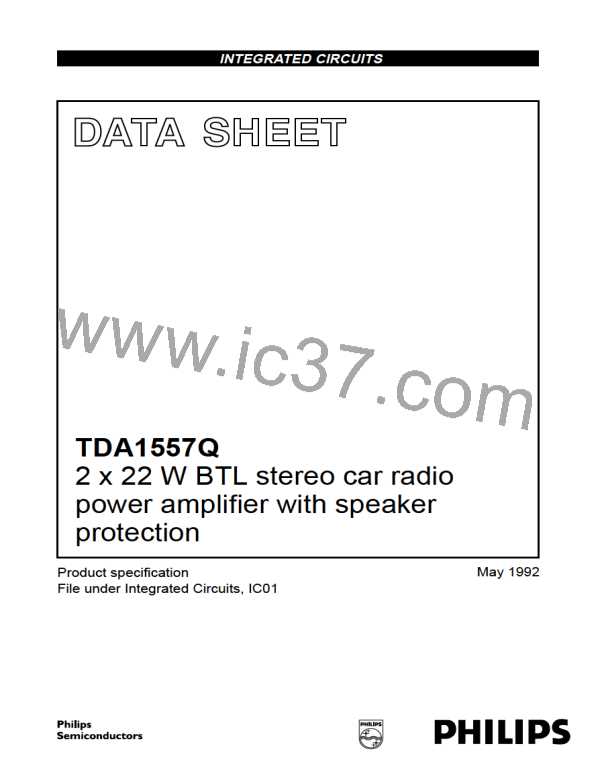Philips Semiconductors
Product specification
2 x 22 W BTL stereo car radio power
amplifier with speaker protection
TDA1557Q
AC CHARACTERISTICS
VP = 14.4 V; RL = 4 Ω; f = 1 kHz; Tamb = 25 °C; unless otherwise specified. See note 1.
SYMBOL
PARAMETER
output power
CONDITIONS
MIN.
TYP.
MAX. UNIT
PO
THD = 0.5%
15
17
−
W
W
W
W
%
THD = 10%
20
−
22
−
−
−
−
−
VP = 13.2 V; THD = 0.5%
VP = 13.2 V; THD = 10%
PO = 1 W
12
−
17
THD
B
total harmonic distortion
power bandwidth
−
0.1
20 to
15 000
25
THD = 0.5%; PO = −1 dB
with respect to 15 W
−1 dB; note 5
−
Hz
flow
low frequency roll-off
−
−
Hz
fhigh
Gv
high frequency roll-off
−1 dB
20
45
−
−
kHz
dB
closed loop voltage gain
supply voltage ripple rejection
46
47
SVRR
ON; note 6
34
38
45
45
80
25
−
−
dB
dB
dB
dB
dB
kΩ
ON; note 7
−
−
ON; note 8
−
−
MUTE; notes 6 and 7
stand-by; notes 6 and 7
−
−
−
−
ZI
input impedance
30
36
Vno
noise output voltage
ON; RS = 0; note 9
RS = 10 kΩ; note 9
MUTE; notes 9 & 10
−
325
350
180
−
500
−
µV
µV
µV
dB
dB
−
−
−
α
channel separation
channel unbalance
40
−
−
∆Gv
−
1
Notes to the characteristics
1. All characteristics are measured using the circuit shown in Fig.4
2. The circuit is DC adjusted at VP = 6 to 18 V and AC operating at VP = 8.5 to 18 V
3. At 18 V < VP < 30 V, the DC output voltage ≤ VP/2
4. Conditions: V11 = 0; short-circuit output to GND; switch V11 to MUTE or ON condition (rise time V11 > 10 µs).
5. Frequency response externally fixed.
6. Ripple rejection measured at the output with a source-impedance of 0 Ω (max. ripple amplitude of 2 V) and a
frequency of 100 Hz.
7. Ripple rejection measured at the output with a source-impedance of 0 Ω (max. ripple amplitude of 2 V) and a
frequency between 1 and 10 kHz.
8. Ripple rejection measured at the output with a source-impedance of 0 Ω (max. ripple amplitude of 2 V) and a
frequency between 100 Hz and 10 kHz. Pin 12 is decoupled with two diodes to ground.
9. Noise voltage measured in a bandwidth of 20 Hz to 20 kHz.
10. Noise output voltage independent of RS (Vin = 0).
May 1992
7

 NXP [ NXP ]
NXP [ NXP ]